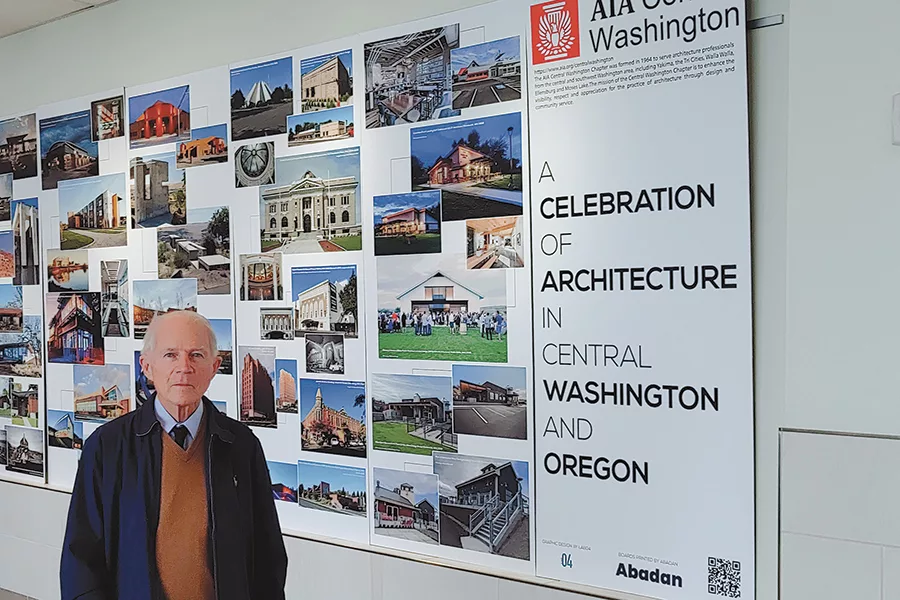
Home » Architects put the spotlight on their best work
Architects put the spotlight on their best work

January 12, 2022
Sharp-eyed travelers with time to kill at the Tri-Cities Airport have always been bombarded with information about local sites.
For 2021 and now early 2022, they’ve had a chance to review something a bit more substantial – the best examples of local architecture from Walla Walla to the Columbia River Gorge, as curated by members of AIA Central Washington.
“The variety of projects showcased really speak to the impact of the work the architectural community provides,” said Brandon Wilm, of Design West Architects and president of the chapter.
“We help envision, conceptualize and construct the communities that we all live in. Architecture seems to have been trivialized with the advent of many 3D software and visualization tools. However, as you can see from the exhibit, these buildings elicit emotions, memories and help create a sense of community when done right.”
Jim Dillman, a retired Richland architect emeritus, led the project. It was a welcome opportunity to highlight great architecture and architects, who often go unnoticed in the lengthy construction process.
The display wraps its yearlong run in January, but Dillman plans to take it on the road. The display has a compelling story to tell and once it escapes the secured confines of the airport terminal, he wants to exhibit it at regional libraries.
During a visit to the airport to take photos, he took measurements, and, ever the architect, sketched out drawings for the frames in a notepad and worried about finding hinges that would support the weight.
Dillman, who grew up in Whitstran near Prosser, and the jury that selected which buildings to feature, included a mix of familiar landmarks and less-known buildings.
The familiar includes Franklin County’s striking courthouse and its classic dome, Richland Lutheran Church, known fondly as the “cupcake” building for its unique conical roof (designed by Funk, Murray and Johnson of Spokane) and the Reach Museum near the Richland Wye (designed by Kennewick architect Terence L. Thornhill).
There are less well-known buildings too, many selected because they echo Dillman’s belief that building design should serve the desert landscape – his own projects have spare lines and gleaming surfaces.
“My attitude about where we are in the community, this is the northern end of the Great American Desert. If you didn’t have all these houses built by Midwesterners, you’d have Albuquerque or LA,” he said. “That was what I wanted the community to be. To me, it’s one of the most beautiful places on the planet.”
There’s the modern home he built in 1980 on the slopes of Badger Mountain. The gleaming building is visible from great distances, but it has one secret – a Chinese inscription of a horse carved into a column in honor of the Horse Heaven Hills.
Kennewick’s Eastgate Elementary by MMEC Architecture made the list too, celebrated for its playful exterior and the way the designers balanced the sheer volume of a school that serves hundreds of people. Educational Service District 123’s Pasco building, by Design West Architects, is another educational facility that won a callout.
Great desert architecture isn’t limited to the Tri-Cities.
The Maryhill Overlook near the Maryhill Museum of Art along Highway 14, designed by Brad Cloepfil of Portland's Allied Works Architecture, uses minimal structure, spare lines and angled cutouts to draw attention to the sweeping desert view.
There is a nod to celebrity architect Maya Lin, who gained national prominence for designing the Vietnam War Memorial in Washington, D.C. Her handiwork is on display at Sacajawea State Park in Pasco, where her Confluence Project invites visitors to contemplate the rich cultural history in a series of rings at the spot where the Snake River joins the Columbia.
The tour is geographically bookended by two academic projects, one in Ellensburg and the other in Walla Walla.
In Ellensburg, Central Washington University’s psychology building is an exemplar of its time. Built in 1972, the midcentury modern design is by Grant, Copeland & Chervenas.
In Walla Walla, Cordiner Hall on the Whitman College campus is the main auditorium and used for ceremonies and similar events. It was designed by Naramore, Bain, Brady and Johnson and built in 1967, thanks to a $500,000 gift from General Electric.
The mix of locations and styles is deliberate, said Dillman, who retired eight years ago at age 75.
“I was trying to tie things from the past. I didn’t limit it to architects from our chapter. I just focused on good architecture.”
Local News Architecture & Engineering
KEYWORDS january 2022





